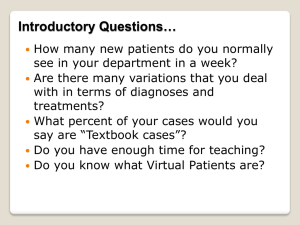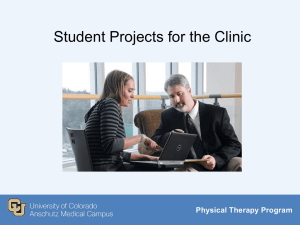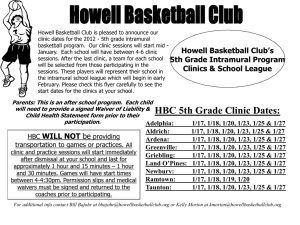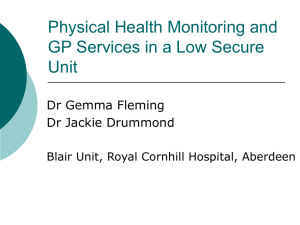Title of Presentation - Collaborative Family Healthcare Association
advertisement
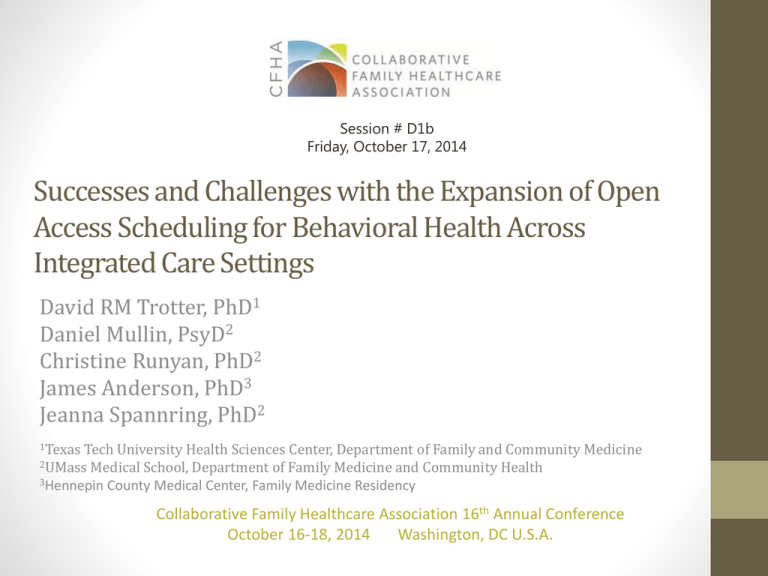
Session # D1b Friday, October 17, 2014 Successes and Challenges with the Expansion of Open Access Scheduling for Behavioral Health Across Integrated Care Settings David RM Trotter, PhD1 Daniel Mullin, PsyD2 Christine Runyan, PhD2 James Anderson, PhD3 Jeanna Spannring, PhD2 1Texas Tech University Health Sciences Center, Department of Family and Community Medicine Medical School, Department of Family Medicine and Community Health 3Hennepin County Medical Center, Family Medicine Residency 2UMass Collaborative Family Healthcare Association 16th Annual Conference October 16-18, 2014 Washington, DC U.S.A. Faculty Disclosure We have not had any relevant financial relationships during the past 12 months. Objectives By the end of this talk, we hope you will be able to: • Describe typical behavioral health no-show rates • Describe the expansion of an open access schedule (OAS) system for BH providers into a diverse group of primary care health centers. • Articulate three lessons learned about OAS through this expansion • Estimate the potential impact of OAS on your behavioral health practice utilization rate. One pressing problem • The demand for behavioral health (BH) providers is outpacing the supply of professionals. • Projected job growth, 2012-2022 • Psychologists • Estimated number of new professionals: 16,400 • Estimated number of new positions: 55,900 • Clinical Social Workers • Estimated number of new professionals: 26,000 • Estimated number of new positions: 50,200 • Masters Level Counselors: • Estimated number of new professionals: 36,700 • Estimated number of new positions: 64,000 (US Department of Labor Data: Retrieved on 10/9/2014 from: http://data.bls.gov/projections/occupationProj) An Opportunity for Quality Improvement: Our challenge! • How can we improve our practice in ways that meet increasing demands? • Our goal: To decrease the impact of “failed appointments” on our BH services • Audience Assessment: In what ways do “failed appointments” impact your professional demands? Background • Wide range of no-show rates for mental health services: • 30-75% no-show rate for initial appointments • 20-60% no-show rate for follow-up appointments 40% Williams et al, 2008) 35% No-Show Rate • Positive correlation between no-show rates and delayed care. (Folkins et al., 1980, 30% 25% 20% 15% 10% 5% 0% <3 days 6-8 days 16-19 days Background • Approximately 26% or missed appointments are the result of “Practical Matters.” (Defife et al., 2010) Pilot Project: Barre, MA (2012-2013) • Goal: To create a patient-centered scheduling system that met the needs of our patients and increased access to care by reducing failed appointments. • OAS in Barre, MA: • Most appointments scheduled within 3 days of the visit • All appointments were “frozen” more than 3 days in advance • Patients were asked to schedule appointments when they want to be seen • A few patients were allowed to “advanced book” appointments Example Session Monday Tuesday Wednesday Thursday Friday Morning 8:008:309:009:3010:0010:3011:0011:30- 8:008:309:009:3010:0010:3011:0011:30- No Clinic No Clinic 8:008:309:009:3010:0010:3011:0011:30- Afternoon 1:001:302:002:303:003:304:00- No Clinic 1:001:302:002:303:003:304:00- 1:001:302:002:303:003:304:00- Admin Evening 5:306:006:30- No Clinic No Clinic No Clinic No Clinic Example Session Monday Tuesday Wednesday Thursday Friday Morning 8:008:309:009:3010:0010:3011:0011:30- 8:008:309:009:3010:0010:3011:0011:30- No Clinic No Clinic 8:008:309:009:3010:0010:3011:0011:30- Afternoon 1:001:302:002:303:003:304:00- No Clinic 1:001:302:002:303:003:304:00- 1:001:302:002:303:003:304:00- Admin Evening 5:306:006:30- No Clinic No Clinic No Clinic No Clinic Example Session Monday Tuesday Wednesday Thursday Friday Morning 8:008:309:009:3010:0010:3011:0011:30- 8:008:309:009:3010:0010:3011:0011:30- No Clinic No Clinic 8:008:309:009:3010:0010:3011:0011:30- Afternoon 1:001:302:002:303:003:304:00- No Clinic 1:001:302:002:303:003:304:00- 1:001:302:002:303:003:304:00- Admin Evening 5:306:006:30- No Clinic No Clinic No Clinic No Clinic Pilot Data • Provider 1: • Utilization increase from 58.6% to 68.5% • No-Shows decreased from 22.4% to 18.3% • Cancelations decreased from 16.8% to 11.4% • Provider 2: • Utilization increase from 61.5% to 62.6% • No-Shows decreased from 18.4% to 14.3% • Cancelations decreased from 15.7% to 9.8% • In summary: Both providers witnessed a 10% increase in utilization or availability Expansion Project • Goal: To demonstrate the portability of the OSA system for behavioral health in a diverse set of primary care health centers • 3 Clinical Sites: • Texas Tech Family Medicine Clinic, Lubbock, TX • Hennepin County Medical Center, Minneapolis, MN • Hahnemann Family Health Center, Worchester, MA Texas Tech University HSC, Family Medicine Clinic Providers: 15 Attending Physicians, 29 Residents, 1 RD, 1 Acupuncturist, 1 BH Provider Issues Relevant to OSA implementation: – Previous OAS system for physicians – Physicians use a “traditional” scheduling model Texas Tech University HSC, Family Medicine Clinic Guidelines for Booking – 7 appointment slots available each ½ day clinic – Follow-Up Appointments booked via OAS • 5 “Frozen Slots” thaw 7 days in advance • 2 “Frozen Slots” thaw 1 day in advance – Providers can authorize advanced booking Texas Tech University HSC, Family Medicine Clinic 90 80 85.4% 70 60 50 % Booked 55.6% % Utilization 40 30 20 10 0 %No-Show 29.8% Texas Tech University HSC, Family Medicine Clinic Lessons Learned Successes: • Availability for same day access to care • Positive feedback from patients and providers Needed Adjustments • Labor intensive process: How can I monitor OAS drift? Critical Issues • Can OSA work in the context of a low BHC to patient ratio? Hennepin County Medical Center • Guidelines for booking: – Each session contains eight, 30-minute slots – Schedule opens 8 days before day in question • E.G., on Monday, 10/13, the Monday, 10/20 schedule will open – Dr. Anderson can schedule patients further out at his discretion Hennepin County Medical Center • Implementation process: – Worked closely with clinic manager – Differs from physician schedule • Unfreezing schedule • Appointment duration – No clear data on patient satisfaction • Seems may be more patient-centered for new vs. established patients Hennepin County Medical Center Percentages (3 Month) 70.0 60.0 50.0 40.0 30.0 % Utilization 60.4% % No-Showed 20.0 10.0 25.6% 34.6% 31.4% 0.0 OSA Traditional Hennepin County Medical Center • Lessons learned: – Clinical lore challenges data – No clear data on patient satisfaction • Seems may be more patient-centered for new vs. established patients – Must keep advocating for maintenance UMass Memorial Hahnemann Family Health Center • Urban Academic Health Center (Primarily serving Medicaid population) • 13 Faculty (2 NPs, 2 BH Providers, 9 MDs) • 12 Residents (4 per PGY) • Additional BH: (1.5) – 3 Post-doctoral Fellows 1 Pre-doctoral Intern 1 Practicum student UMass Memorial Hahnemann Family Health Center October 2013 Implemented Open Access • Schedules frozen until 3 days prior • Any provider could override the freeze and schedule a patient • Instructed patients to the change and when to call vis-à-vis the agreed upon duration before next visit • No open access for MDs when we began open access – More recently, one medical provider designated for same day acute care/urgent visits for the session UMass Memorial, Hahnemann Family Health Center Provider 1, Percentages (6 Months Pre, 8 Months Post) 90.0 85.3 80.0 70.0 66.1 60.0 50.0 52.2 40.0 42.8 30.0 20.0 10.0 24.1 % Booked % Utilization % Canceled 21.2 17.3 10.7 0.0 Pre-OSA Post-OSA % No-Showed UMass Memorial Hahnemann Family Health Center Provider 1, Raw Data (6 Months Pre, 8 Months Post) 160.0 140.0 134 120.0 Allocated 100.0 Booked 80.0 60.0 40.0 20.0 70.2 58 77 65.8 51 32 14 0.0 Pre-OSA (Average) 16 13 Post-OSA (Average) Utilized Canceled No-Showed UMass Memorial Hahnemann Family Health Center Provider 2, Percentages (3 months pre, 8 months post) 100% 90% 86.34% 84.05% 80% 70% %booked 63.35% 62.76% 60% NSH% 50% 40% 30% 20% % utilization 33.75% 26.79% 23.58% 20.48% 10% 0% Pre-OSA Average Percentage Post-OSA cancel% UMass Memorial Hahnemann Family Health Center Provider 2, Raw Data (3 months pre, 8 months post) 70 60 50 40 59.33 50 42.50 36 35.125 30 26.625 20 14.125 10 13.67 14 available booked arrived canceled no showed 8.375 0 Pre-OSA Post-OSA Monthly Average UMass Memorial Hahnemann Family Health Center Successes: – Excellent access for new patients – Providers were pleased at ease of quick scheduling Needed Adjustments: – Because of part time BH providers, 3 days was hard for patients to judge because they do not know our schedules (days in and out of clinic) – Frustrating process at time b/c of phones Where We Are Now: – Determined one week thawing was preferable for patients – Remains to be seen how this impacts no show rates/cancelations/utilization Lessons Learned What is the most important thing we learned about OAS in our clinics? Learning Assessment Audience Question & Answer References • • • • • • • • • • Berg, B., Murr, M., Chermak, D., Wolldall, J., Pignone, M., Sandler, D., & Denton, B. (2013). Estimating the Cost of No-Shows and Evaluating the Effects of Mitigation Strategies. Medical Decision Making (Online only, Downloaded from mdm.sagepub.com on 10/7/2013) Defife, J., Conklin, C., Smith, J., & Poole, J. (2010). Psychotherapy Appiontment No-shows; Rates and Reasons. Psychotherapy Theory, Research, Practice, Training 47(3), 413-417. Folkins, C., Hersch, P., Dahlen, D. (1980). Waiting time and No-Show Rate in a Community Mental Health Center. American Journal of Community Psychology, 8(1), 121-123. Guck, T., Guck, A., Brack, A., Frey, D. (2007). No-Show Rates in Partially Integrated Models of Behavioral Health Care in a Primary Care Setting. Families, Systems, and Health, 25(2), 137-146. Macharia, W., Leon, G., Roewe, B., Stephenson, B., & Haynes, R. (1992). An overview of interventions to improve compliance with appointment keeping for medical services. Journal of the American Medical Association, 267, 1813-1817. Patrick, J. (2011). A Markov Decision Model for Determining Optimal Outpatient Scheduling. Health Care Management Science 15(2), 91-102 Rose, K., Ross, J., & Horwitz, L. (2011). Advanced Assess Scheduling Outcomes. Archives of Internal Medicine 171(13), 1150-1159. US Department of Labor, Bureau of Labor Statistics. Retrieved from http://data.bls.gov/projections/occupationProj on 10/9/2014 Westra, H., Boardman, C., & Moran-Tynski, S. (2000). Regarding The impact of providing preassesssment information on no-show rates. Canadian Journal of Psychiatry, 6, 1-2. Williams, M. E., Latta, J., & Conversano, P. (2008). Eliminating the wait for mental health services. The Journal of Behavioral Health Services and Research, 35(1), 107–114. Session Evaluation Please complete and return the evaluation form to the classroom monitor before leaving this session. Thank you!
